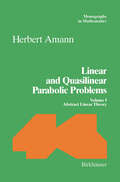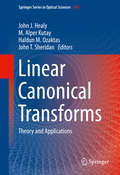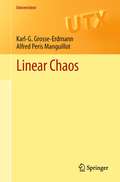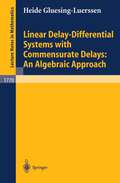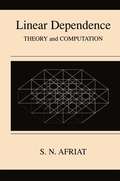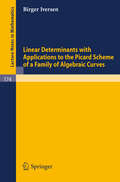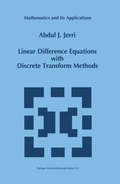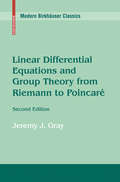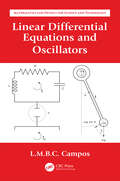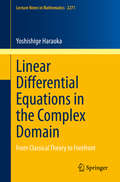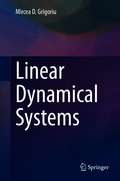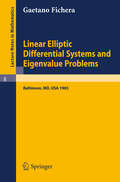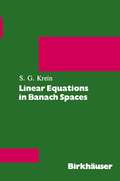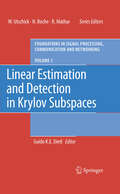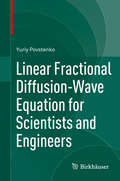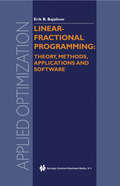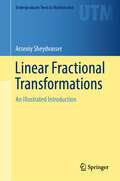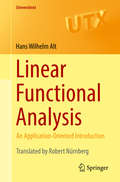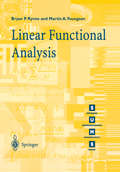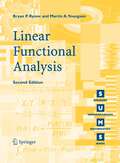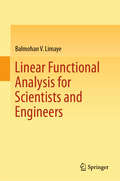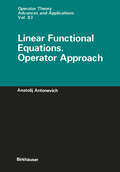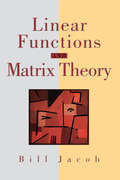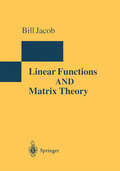- Table View
- List View
Linear and Quasilinear Parabolic Problems: Volume I: Abstract Linear Theory (Monographs in Mathematics #89)
by Herbert AmannIn this treatise we present the semigroup approach to quasilinear evolution equa of parabolic type that has been developed over the last ten years, approxi tions mately. It emphasizes the dynamic viewpoint and is sufficiently general and flexible to encompass a great variety of concrete systems of partial differential equations occurring in science, some of those being of rather 'nonstandard' type. In partic ular, to date it is the only general method that applies to noncoercive systems. Although we are interested in nonlinear problems, our method is based on the theory of linear holomorphic semigroups. This distinguishes it from the theory of nonlinear contraction semigroups whose basis is a nonlinear version of the Hille Yosida theorem: the Crandall-Liggett theorem. The latter theory is well-known and well-documented in the literature. Even though it is a powerful technique having found many applications, it is limited in its scope by the fact that, in concrete applications, it is closely tied to the maximum principle. Thus the theory of nonlinear contraction semigroups does not apply to systems, in general, since they do not allow for a maximum principle. For these reasons we do not include that theory.
Linear Canonical Transforms: Theory and Applications (Springer Series in Optical Sciences #198)
by John J. Healy M. Alper Kutay Haldun M. Ozaktas John T. SheridanThis book provides a clear and accessible introduction to the essential mathematical foundations of linear canonical transforms from a signals and systems perspective. Substantial attention is devoted to how these transforms relate to optical systems and wave propagation. There is extensive coverage of sampling theory and fast algorithms for numerically approximating the family of transforms. Chapters on topics ranging from digital holography to speckle metrology provide a window on the wide range of applications.This volume will serve as a reference for researchers in the fields of image and signal processing, wave propagation, optical information processing and holography, optical system design and modeling, and quantum optics. It will be of use to graduate students in physics and engineering, as well as for scientists in other areas seeking to learn more about this important yet relatively unfamiliar class of integral transformations.
Linear Chaos (Universitext)
by Karl-G. Grosse-Erdmann Alfred Peris ManguillotIt is commonly believed that chaos is linked to non-linearity, however many (even quite natural) linear dynamical systems exhibit chaotic behavior. The study of these systems is a young and remarkably active field of research, which has seen many landmark results over the past two decades. Linear dynamics lies at the crossroads of several areas of mathematics including operator theory, complex analysis, ergodic theory and partial differential equations. At the same time its basic ideas can be easily understood by a wide audience. Written by two renowned specialists, Linear Chaos provides a welcome introduction to this theory. Split into two parts, part I presents a self-contained introduction to the dynamics of linear operators, while part II covers selected, largely independent topics from linear dynamics. More than 350 exercises and many illustrations are included, and each chapter contains a further ‘Sources and Comments’ section. The only prerequisites are a familiarity with metric spaces, the basic theory of Hilbert and Banach spaces and fundamentals of complex analysis. More advanced tools, only needed occasionally, are provided in two appendices. A self-contained exposition, this book will be suitable for self-study and will appeal to advanced undergraduate or beginning graduate students. It will also be of use to researchers in other areas of mathematics such as partial differential equations, dynamical systems and ergodic theory.
Linear Delay-Differential Systems with Commensurate Delays: An Algebraic Approach (Lecture Notes in Mathematics #1770)
by Heide Gluesing-LuerssenThe book deals with linear time-invariant delay-differential equations with commensurated point delays in a control-theoretic context. The aim is to show that with a suitable algebraic setting a behavioral theory for dynamical systems described by such equations can be developed. The central object is an operator algebra which turns out to be an elementary divisor domain and thus provides the main tool for investigating the corresponding matrix equations. The book also reports the results obtained so far for delay-differential systems with noncommensurate delays. Moreover, whenever possible it points out similarities and differences to the behavioral theory of multidimensional systems, which is based on a great deal of algebraic structure itself. The presentation is introductory and self-contained. It should also be accessible to readers with no background in delay-differential equations or behavioral systems theory. The text should interest researchers and graduate students.
Linear Dependence: Theory and Computation
by Sydney N. AfriatDeals with the most basic notion of linear algebra, to bring emphasis on approaches to the topic serving at the elementary level and more broadly. A typical feature is where computational algorithms and theoretical proofs are brought together. Another is respect for symmetry, so that when this has some part in the form of a matter it should also be reflected in the treatment. Issues relating to computational method are covered. These interests may have suggested a limited account, to be rounded-out suitably. However this limitation where basic material is separated from further reaches of the subject has an appeal of its own. To the `elementary operations' method of the textbooks for doing linear algebra, Albert Tucker added a method with his `pivot operation'. Here there is a more primitive method based on the `linear dependence table', and yet another based on `rank reduction'. The determinant is introduced in a completely unusual upside-down fashion where Cramer's rule comes first. Also dealt with is what is believed to be a completely new idea, of the `alternant', a function associated with the affine space the way the determinant is with the linear space, with n+1 vector arguments, as the determinant has n. Then for affine (or barycentric) coordinates we find a rule which is an unprecedented exact counterpart of Cramer's rule for linear coordinates, where the alternant takes on the role of the determinant. These are among the more distinct or spectacular items for possible novelty, or unfamiliarity. Others, with or without some remark, may be found scattered in different places.
Linear Determinants with Applications to the Picard Scheme of a Family of Algebraic Curves (Lecture Notes in Mathematics #174)
by Birger Iversena
Linear Difference Equations with Discrete Transform Methods (Mathematics and Its Applications #363)
by A.J. JerriThis book covers the basic elements of difference equations and the tools of difference and sum calculus necessary for studying and solv ing, primarily, ordinary linear difference equations. Examples from various fields are presented clearly in the first chapter, then discussed along with their detailed solutions in Chapters 2-7. The book is in tended mainly as a text for the beginning undergraduate course in difference equations, where the "operational sum calculus" of the di rect use of the discrete Fourier transforms for solving boundary value problems associated with difference equations represents an added new feature compared to other existing books on the subject at this introductory level. This means that in addition to the familiar meth ods of solving difference equations that are covered in Chapter 3, this book emphasizes the use of discrete transforms. It is an attempt to introduce the methods and mechanics of discrete transforms for solv ing ordinary difference equations. The treatment closely parallels what many students have already learned about using the opera tional (integral) calculus of Laplace and Fourier transforms to solve differential equations. As in the continuous case, discrete operational methods may not solve problems that are intractable by other meth ods, but they can facilitate the solution of a large class of discrete initial and boundary value problems. Such operational methods, or what we shall term "operational sum calculus," may be extended eas ily to solve partial difference equations associated with initial and/or boundary value problems.
Linear Differential Equations and Group Theory from Riemann to Poincare (Modern Birkhäuser Classics)
by Jeremy GrayThis book is a study of how a particular vision of the unity of mathematics, often called geometric function theory, was created in the 19th century. The central focus is on the convergence of three mathematical topics: the hypergeometric and related linear differential equations, group theory, and on-Euclidean geometry. The text for this second edition has been greatly expanded and revised, and the existing appendices enriched. The exercises have been retained, making it possible to use the book as a companion to mathematics courses at the graduate level.
Linear Differential Equations and Oscillators (Mathematics and Physics for Science and Technology)
by Luis Manuel Braga da Costa CamposLinear Differential Equations and Oscillators is the first book within Ordinary Differential Equations with Applications to Trajectories and Vibrations, Six-volume Set. As a set, they are the fourth volume in the series Mathematics and Physics Applied to Science and Technology. This first book consists of chapters 1 and 2 of the fourth volume. The first chapter covers linear differential equations of any order whose unforced solution can be obtained from the roots of a characteristic polynomial, namely those: (i) with constant coefficients; (ii) with homogeneous power coefficients with the exponent equal to the order of derivation. The method of characteristic polynomials is also applied to (iii) linear finite difference equations of any order with constant coefficients. The unforced and forced solutions of (i,ii,iii) are examples of some general properties of ordinary differential equations. The second chapter applies the theory of the first chapter to linear second-order oscillators with one degree-of-freedom, such as the mechanical mass-damper-spring-force system and the electrical self-resistor-capacitor-battery circuit. In both cases are treated free undamped, damped, and amplified oscillations; also forced oscillations including beats, resonance, discrete and continuous spectra, and impulsive inputs. Describes general properties of differential and finite difference equations, with focus on linear equations and constant and some power coefficients Presents particular and general solutions for all cases of differential and finite difference equations Provides complete solutions for many cases of forcing including resonant cases Discusses applications to linear second-order mechanical and electrical oscillators with damping Provides solutions with forcing including resonance using the characteristic polynomial, Green' s functions, trigonometrical series, Fourier integrals and Laplace transforms
Linear Differential Equations and Oscillators (Mathematics and Physics for Science and Technology)
by Luis Manuel Braga da Costa CamposLinear Differential Equations and Oscillators is the first book within Ordinary Differential Equations with Applications to Trajectories and Vibrations, Six-volume Set. As a set, they are the fourth volume in the series Mathematics and Physics Applied to Science and Technology. This first book consists of chapters 1 and 2 of the fourth volume. The first chapter covers linear differential equations of any order whose unforced solution can be obtained from the roots of a characteristic polynomial, namely those: (i) with constant coefficients; (ii) with homogeneous power coefficients with the exponent equal to the order of derivation. The method of characteristic polynomials is also applied to (iii) linear finite difference equations of any order with constant coefficients. The unforced and forced solutions of (i,ii,iii) are examples of some general properties of ordinary differential equations. The second chapter applies the theory of the first chapter to linear second-order oscillators with one degree-of-freedom, such as the mechanical mass-damper-spring-force system and the electrical self-resistor-capacitor-battery circuit. In both cases are treated free undamped, damped, and amplified oscillations; also forced oscillations including beats, resonance, discrete and continuous spectra, and impulsive inputs. Describes general properties of differential and finite difference equations, with focus on linear equations and constant and some power coefficients Presents particular and general solutions for all cases of differential and finite difference equations Provides complete solutions for many cases of forcing including resonant cases Discusses applications to linear second-order mechanical and electrical oscillators with damping Provides solutions with forcing including resonance using the characteristic polynomial, Green' s functions, trigonometrical series, Fourier integrals and Laplace transforms
Linear Differential Equations in the Complex Domain: From Classical Theory to Forefront (Lecture Notes in Mathematics #2271)
by Yoshishige HaraokaThis book provides a detailed introduction to recent developments in the theory of linear differential systems and integrable total differential systems. Starting from the basic theory of linear ordinary differential equations and integrable systems, it proceeds to describe Katz theory and its applications, extending it to the case of several variables. In addition, connection problems, deformation theory, and the theory of integral representations are comprehensively covered. Complete proofs are given, offering the reader a precise account of the classical and modern theory of linear differential equations in the complex domain, including an exposition of Pfaffian systems and their monodromy problems. The prerequisites are a course in complex analysis and the basics of differential equations, topology and differential geometry. This book will be useful for graduate students, specialists in differential equations, and for non-specialists who want to use differential equations.
Linear Dynamical Systems
by Mircea D. GrigoriuThis textbook provides a concise, clear, and rigorous presentation of the dynamics of linear systems that delivers the necessary tools for the analysis and design of mechanical/ structural systems, regardless of their complexity. The book is written for senior undergraduate and first year graduate students as well as engineers working on the design of mechanical/structural systems subjected to dynamic actions, such as wind/earthquake engineers and mechanical engineers working on wind turbines. Professor Grigoriu's lucid presentation maximizes student understanding of the formulation and the solution of linear systems subjected to dynamic actions, and provides a clear distinction between problems of practical interest and their special cases. Based on the author's lecture notes from courses taught at Cornell University, the material is class-tested over many years and ideal as a core text for a range of classes in mechanical, civil, and geotechnical engineering, as well as for self-directed learning by practitioners in the field.
Linear Elliptic Differential Systems and Eigenvalue Problems (Lecture Notes in Mathematics #8)
by Gaetano FicheraLinear Equations in Banach Spaces
by KREININTRODUCTION . . . . . . xiii § 1. LINEAR EQUATIONS. BASIC NOTIONS . 3 § 2. EQUATIONS WITH A CLOSED OPERATOR 6 § 3. THE ADJOINT EQUATION . . . . . . 10 § 4. THE EQUATION ADJOINT TO THE FACTORED EQUATION. 17 § 5. AN EQUATION WITH A CLOSED OPERATOR WHICH HAS A DENSE DOMAIN 18 NORMALLY SOLVABLE EQUATIONS WITH FINITE DIMENSIONAL KERNEL. 22 § 6. A PRIORI ESTIMATES .. . . . . . 24 § 7. EQUATIONS WITH FINITE DEFECT . . . 27 § 8. § 9. SOME DIFFERENT ADJOINT EQUATIONS . 30 § 10. LINEAR TRANSFORMATIONS OF EQUATIONS 33 TRANSFORMATIONS OF d-NORMAL EQUATIONS . 38 § 11. § 12. NOETHERIAN EQUATIONS. INDEX. . . . . . 42 § 13. EQUATIONS WITH OPERATORS WHICH ACT IN A SINGLE SPACE 44 § 14. FREDHOLM EQUATIONS. REGULARIZATION OF EQUATIONS 46 § 15. LINEAR CHANGES OF VARIABLE . . . . . . . . 50 § 16. STABILITY OF THE PROPERTIES OF AN EQUATION 53 OVERDETERMINED EQUATIONS 59 § 17. § 18. UNDETERMINED EQUATIONS 62 § 19. INTEGRAL EQUATIONS . . . 65 DIFFERENTIAL EQUATIONS . 80 § 20. APPENDIX. BASIC RESULTS FROM FUNCTIONAL ANALYSIS USED IN THE TEXT 95 LITERATURE CITED . . . . . . . . . . . . . . . . . . .. . . . 99 . . PRE F ACE The basic material appearing in this book represents the substance v of a special series of lectures given by the author at Voronez University in 1968/69, and, in part, at Dagestan University in 1970.
Linear Estimation and Detection in Krylov Subspaces (Foundations in Signal Processing, Communications and Networking #1)
by Guido K. DietlThis book focuses linear estimation theory, which is essential for effective signal processing. The first section offers a comprehensive overview of key methods like reduced-rank signal processing and Krylov subspace methods of numerical mathematics. Also, the relationship between statistical signal processing and numerical mathematics is presented. In the second part, the theory is applied to iterative multiuser detection receivers (Turbo equalization) which are typically desired in wireless communications systems.
Linear Fractional Diffusion-Wave Equation for Scientists and Engineers
by Yuriy PovstenkoThis book systematically presents solutions to the linear time-fractional diffusion-wave equation. It introduces the integral transform technique and discusses the properties of the Mittag-Leffler, Wright, and Mainardi functions that appear in the solutions. The time-nonlocal dependence between the flux and the gradient of the transported quantity with the “long-tail” power kernel results in the time-fractional diffusion-wave equation with the Caputo fractional derivative. Time-nonlocal generalizations of classical Fourier’s, Fick’s and Darcy’s laws are considered and different kinds of boundary conditions for this equation are discussed (Dirichlet, Neumann, Robin, perfect contact). The book provides solutions to the fractional diffusion-wave equation with one, two and three space variables in Cartesian, cylindrical and spherical coordinates.The respective sections of the book can be used for university courses on fractional calculus, heat and mass transfer, transport processes in porous media and fractals for graduate and postgraduate students. The volume will also serve as a valuable reference guide for specialists working in applied mathematics, physics, geophysics and the engineering sciences.
Linear-Fractional Programming Theory, Methods, Applications and Software (Applied Optimization #84)
by E.B. BajalinovThis is a book on Linear-Fractional Programming (here and in what follows we will refer to it as "LFP"). The field of LFP, largely developed by Hungarian mathematician B. Martos and his associates in the 1960's, is concerned with problems of op timization. LFP problems deal with determining the best possible allo cation of available resources to meet certain specifications. In particular, they may deal with situations where a number of resources, such as people, materials, machines, and land, are available and are to be combined to yield several products. In linear-fractional programming, the goal is to determine a per missible allocation of resources that will maximize or minimize some specific showing, such as profit gained per unit of cost, or cost of unit of product produced, etc. Strictly speaking, linear-fractional programming is a special case of the broader field of Mathematical Programming. LFP deals with that class of mathematical programming problems in which the relations among the variables are linear: the con straint relations (i.e. the restrictions) must be in linear form and the function to be optimized (i.e. the objective function) must be a ratio of two linear functions.
Linear Fractional Transformations: An Illustrated Introduction (Undergraduate Texts in Mathematics)
by Arseniy SheydvasserThe principle aim of this unique text is to illuminate the beauty of the subject both with abstractions like proofs and mathematical text, and with visuals, such as abundant illustrations and diagrams. With few mathematical prerequisites, geometry is presented through the lens of linear fractional transformations. The exposition is motivational and the well-placed examples and exercises give students ample opportunity to pause and digest the material. The subject builds from the fundamentals of Euclidean geometry, to inversive geometry, and, finally, to hyperbolic geometry at the end. Throughout, the author aims to express the underlying philosophy behind the definitions and mathematical reasoning. This text may be used as primary for an undergraduate geometry course or a freshman seminar in geometry, or as supplemental to instructors in their undergraduate courses in complex analysis, algebra, and number theory. There are elective courses that bring together seemingly disparate topics and this text would be a welcome accompaniment.
Linear Functional Analysis: An Application-Oriented Introduction (Universitext)
by Hans Wilhelm AltThis book gives an introduction to Linear Functional Analysis, which is a synthesis of algebra, topology, and analysis. In addition to the basic theory it explains operator theory, distributions, Sobolev spaces, and many other things. The text is self-contained and includes all proofs, as well as many exercises, most of them with solutions. Moreover, there are a number of appendices, for example on Lebesgue integration theory.A complete introduction to the subject, Linear Functional Analysis will be particularly useful to readers who want to quickly get to the key statements and who are interested in applications to differential equations.
Linear Functional Analysis (Springer Undergraduate Mathematics Series)
by Bryan Rynne M.A. YoungsonThis book provides an introduction to the ideas and methods of linear func tional analysis at a level appropriate to the final year of an undergraduate course at a British university. The prerequisites for reading it are a standard undergraduate knowledge of linear algebra and real analysis (including the the ory of metric spaces). Part of the development of functional analysis can be traced to attempts to find a suitable framework in which to discuss differential and integral equa tions. Often, the appropriate setting turned out to be a vector space of real or complex-valued functions defined on some set. In general, such a vector space is infinite-dimensional. This leads to difficulties in that, although many of the elementary properties of finite-dimensional vector spaces hold in infinite dimensional vector spaces, many others do not. For example, in general infinite dimensional vector spaces there is no framework in which to make sense of an alytic concepts such as convergence and continuity. Nevertheless, on the spaces of most interest to us there is often a norm (which extends the idea of the length of a vector to a somewhat more abstract setting). Since a norm on a vector space gives rise to a metric on the space, it is now possible to do analysis in the space. As real or complex-valued functions are often called functionals, the term functional analysis came to be used for this topic. We now briefly outline the contents of the book.
Linear Functional Analysis (Springer Undergraduate Mathematics Series)
by Bryan Rynne M.A. YoungsonThis introduction to the ideas and methods of linear functional analysis shows how familiar and useful concepts from finite-dimensional linear algebra can be extended or generalized to infinite-dimensional spaces. Aimed at advanced undergraduates in mathematics and physics, the book assumes a standard background of linear algebra, real analysis (including the theory of metric spaces), and Lebesgue integration, although an introductory chapter summarizes the requisite material. A highlight of the second edition is a new chapter on the Hahn-Banach theorem and its applications to the theory of duality.
Linear Functional Analysis for Scientists and Engineers
by Balmohan V. LimayeThis book provides a concise and meticulous introduction to functional analysis. Since the topic draws heavily on the interplay between the algebraic structure of a linear space and the distance structure of a metric space, functional analysis is increasingly gaining the attention of not only mathematicians but also scientists and engineers. The purpose of the text is to present the basic aspects of functional analysis to this varied audience, keeping in mind the considerations of applicability. A novelty of this book is the inclusion of a result by Zabreiko, which states that every countably subadditive seminorm on a Banach space is continuous. Several major theorems in functional analysis are easy consequences of this result.The entire book can be used as a textbook for an introductory course in functional analysis without having to make any specific selection from the topics presented here. Basic notions in the setting of a metric space are defined in terms of sequences. These include total boundedness, compactness, continuity and uniform continuity. Offering concise and to-the-point treatment of each topic in the framework of a normed space and of an inner product space, the book represents a valuable resource for advanced undergraduate students in mathematics, and will also appeal to graduate students and faculty in the natural sciences and engineering. The book is accessible to anyone who is familiar with linear algebra and real analysis.
Linear Functional Equations. Operator Approach (Operator Theory: Advances and Applications #83)
by Anatolij AntonevichIn this book we shall study linear functional equations of the form m bu(x) == Lak(X)U(Qk(X)) = f(x), (1) k=l where U is an unknown function from a given space F(X) of functions on a set X, Qk: X -+ X are given mappings, ak and f are given functions. Our approach is based on the investigation of the operators given by the left-hand side of equa tion (1). In what follows such operators will be called functional operators. We will pay special attention to the spectral properties of functional operators, first of all, to invertibility and the Noether property. Since the set X, the space F(X), the mappings Qk and the coefficients ak are arbitrary, the class of operators of the form (1) is very rich and some of its individ ual representatives are related with problems arising in various areas of mathemat ics and its applications. In addition to the classical theory of functional equations, among such areas one can indicate the theory of functional-differential equations with deviating argument, the theory of nonlocal problems for partial differential equations, the theory of boundary value problems for the equation of a vibrating string and equations of mixed type, a number of problems of the general theory of operator algebras and the theory of dynamical systems, the spectral theory of au tomorphisms of Banach algebras, and other problems.
Linear Functions and Matrix Theory (Textbooks in Mathematical Sciences)
by Bill JacobCourses that study vectors and elementary matrix theory and introduce linear transformations have proliferated greatly in recent years. Most of these courses are taught at the undergraduate level as part of, or adjacent to, the second-year calculus sequence. Although many students will ultimately find the material in these courses more valuable than calculus, they often experience a class that consists mostly of learning to implement a series of computational algorithms. The objective of this text is to bring a different vision to this course, including many of the key elements called for in current mathematics-teaching reform efforts. Three of the main components of this current effort are the following: 1. Mathematical ideas should be introduced in meaningful contexts, with after a clear understanding formal definitions and procedures developed of practical situations has been achieved. 2. Every topic should be treated from different perspectives, including the numerical, geometric, and symbolic viewpoints. 3. The important ideas need to be visited repeatedly throughout the term, with students' understan9ing deepening each time. This text was written with these three objectives in mind. The first two chapters deal with situations requiring linear functions (at times, locally linear functions) or linear ideas in geometry for their understanding. These situations provide the context in which the formal mathematics is developed, and they are returned to with increasing sophistication throughout the text.
Linear Functions and Matrix Theory (Encyclopaedia of Mathematical Sciences #1)
by Bill JacobCourses that study vectors and elementary matrix theory and introduce linear transformations have proliferated greatly in recent years. Most of these courses are taught at the undergraduate level as part of, or adjacent to, the second-year calculus sequence. Although many students will ultimately find the material in these courses more valuable than calculus, they often experience a class that consists mostly of learning to implement a series of computational algorithms. The objective of this text is to bring a different vision to this course, including many of the key elements called for in current mathematics-teaching reform efforts. Three of the main components of this current effort are the following: 1. Mathematical ideas should be introduced in meaningful contexts, with formal definitions and procedures developed after a clear understanding of practical situations has been achieved. 2. Every topic should be treated from different perspectives, including the numerical, geometric,and symbolic viewpoints. 3. The important ideas need to be visited repeatedly throughout the term, with students' understanding deepening each time. This text was written with these three objectives in mind. The first two chapters deal with situations requiring linear functions (at times, locally linear functions) or linear ideas in geometry for their understanding. These situations provide the context in which the formal mathematics is developed, and they are returned to with increasing sophistication throughout the text.
